#cook:いりごま
Explore tagged Tumblr posts
Photo

✿ さば味噌バターの豆腐のせ ✍️ 味噌小2,めんつゆ小1,白ワイン大1,スパイス,いりごま
#cook:サバ缶#cook:さば缶#cook:白ワイン×味噌×めんつゆ#cook:いりごま#cook:木綿豆腐#cook:豆腐#cook:白ワイン×バター×味噌×めんつゆ#cook#cook:2020〜#2020〜#cook:魚#cook:魚:2020〜#cook:味噌
2 notes
·
View notes
Text
今日のお昼ご飯は〜
賞味期限切れになりそうなネギと卵を使いたかったので、ネギをのせたオムライスを作りました!

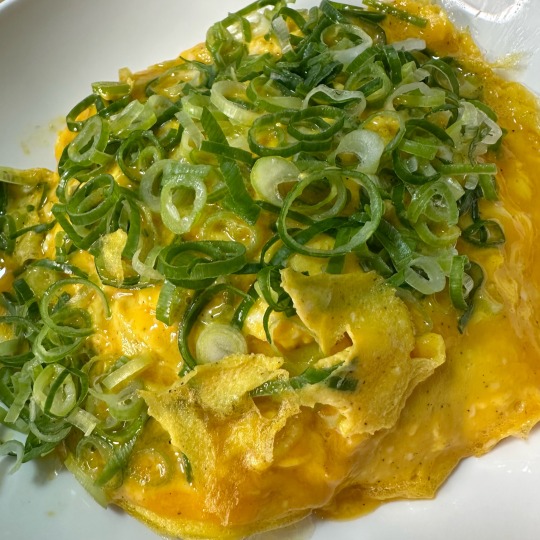


なんか美味くできましたw
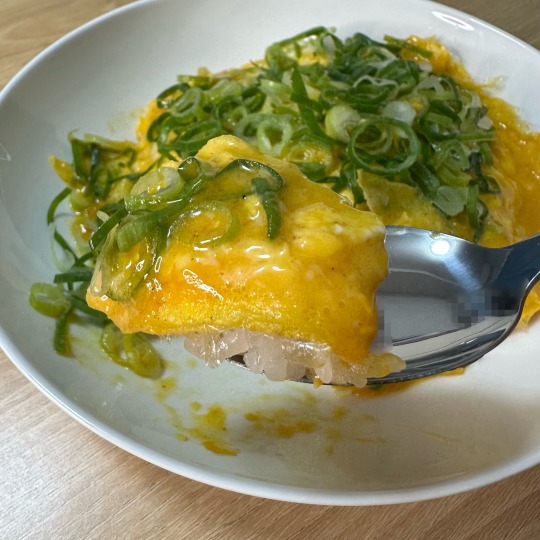
美味しかった〜
ごちそうさまでした😋️
#俺の#私の#お昼ご飯#おひるごはん#ランチ#lunch#卵#ネギ#オムライス#作りました#クッキング#cooking#料理#食べた#美味しかった#おいしい#delicious#ごちそうさま#おうちご飯#世田谷#食べスタグラム
1 note
·
View note
Text

こふく:通称こふ、こふちゃん、稀にこふたん、こふたろう、こふくさん、別名脅威の黒猫
2022年7月、約2ヶ月半で保護施設から引き取られた。脱肛しており長くないかもと言われていたが、無事改善しすくすく育つ。
Jさんに日々挑みかかる強気な幼少期を送るも実は怖がりで、たまのお客さんはおろかじいちゃんにすら挨拶したことがない内弁慶。
だっこを嫌い、呼べば逃げ、最近は何を考えているか分からない顔で床に落ちており、家主ですら意思疎通は困難。しかし朝家主が目覚めると枕シェアによる寄り添いサービスを行っており、一定の愛情はあるもよう。
米をこよなく愛し、炊きたてご飯や準備中の餅米をむしゃむしゃと食べる。また物理的に我が道を行くため多くの物を壊し、実はかなり家主に散財させている。
Kofuku: known as Kofu, Kofu-chan, rarely Kofutan, Kofutaro,or Kofuku-san, and the alias is the black menace
He was adopted from the animal shelter when he was around 2months and a half. Although it was said he might not live so long because he had the anal prolapse, now he has no problems and has gotten so big.
He had a violent childhood attacking Mr.J every day, but his nature is only a home tiger so he can't greet with not only her guests but grandpa yet.
He hates being hugged, runs away when she calls him, and falls on the floor with the face that doesn't know what he's thinking these days, so it's still impossible for landlady to communicate with him. She can feel his affection only by his staying beside service with sharing her pillow when she wakes up.
He loves rice SO much and eats cooked rice or prepared mochi rice. And he always goes his way physically,then broke a lot of things at home so he let her spend quite an extra money...
5K notes
·
View notes
Text
Compliments in Japanese
How do you give compliments in Japanese? Japanese tends to be a very 曖昧 (あいまい) or vague language, so direct compliments tend to be less common.
お世辞 おせじ compliment
誉め言葉 ほめことば compliment, praise
Here are some compliments that can be used in most situations.

Appearance・見た目
Polite 髪の毛切りましたか?似合いますね。 かみのけきりましたか?にあいますね。 Did you cut your hair? It looks good on you.
Casual 髪の毛切った?似合うよ。 かみのけきった?にあうよ。 Did you cut your hair? It looks good.
Polite そのシャツ/ワンピース/服いいですね。 そのシャツ/ワンピース/ふくいいですね。 That shirt/dress/outfit looks good.
Casual そのシャツ/ワンピース/服いいね。 そのシャツ/ワンピース/ふくいいね。 That shirt/dress/outfit looks good.
Polite いい笑顔ですね。 いいえがおですね。 You have a nice smile.
Casual いい笑顔だね。 いいえがおだね。 You have a nice smile.
Work・仕事
Polite 良くやりましたね! よくやりましたね! Good job! / Well done!
Casual 良くやったね! よくやったね! Good job! / Well done!
Polite お見事です! おみごとです! Great work! / Excellent!
Casual お見事! おみごと! Great work! / Excellent!
Polite 今日のプレゼン/スピーチ/アイディアとても良かったです。 きょうのプレゼン/スピーチ/アイディアとてもよかったです。 Today's presentation/speech/idea was very good.
Casual 今日のプレゼン/スピーチ/アイディアとても良かったよ。 きょうのプレゼン/スピーチ/アイディアとてもよかったよ。 Today's presentation/speech/idea was very good.
Skill・腕前
Polite 料理上手ですね。 りょうりじょうずですね。 You are good at cooking.
Casual 料理上手いね。 りょうりうまいね。 You are a good cook.
Polite 写真を撮るセンスがいいですね。 しゃしんをとるセンスがいいですね。 You have good photography sense.
Casual 写真を撮るセンスがいいね。 しゃしんをとるセンスがいいね。 You have good photography sense.
Polite 英語がペラペラですね。 えいごがペラペラですね。 Your English is very fluent.
Casual 英語がペラペラだね。 えいごがペラペラだね。 Your English is very fluent.
#日本語#japanese#japanese langblr#japanese studyblr#langblr#studyblr#compliments in japanese#japanese language#tokidokitokyo#tdtstudy
297 notes
·
View notes
Text
YouTube Channels for Kids by JLPT Levels
(。•̀ᴗ-)✧ resources
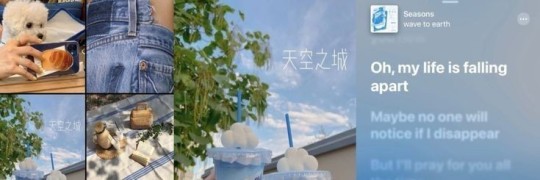
こんにちは, Japanese learners! Learning a language is an exciting adventure, isn't it? To add a spark of joy to your Japanese learning journey, here's a collection of YouTube channels tailored for kids. Organized by JLPT levels, these channels offer a blend of education and entertainment for learners at different stages. Keep in mind, though, that JLPT levels aren't an exact science like math – language learning can be subjective in terms of difficulty. However, these resources provide a fantastic starting point and a fun way to explore the world of Japanese language and culture. Let's hop into this delightful world of animated learning and playful discoveries!
Friendly reminder to adjust your way of learning in order to make the most of what you're studying to reach the goal you truly want! read my post about it (ᵔ◡ᵔ)
꒰ა ˚₊ ✧・┈・╴N 5 ╴・┈・𐑺 ‧₊˚໒꒱
— Curious George (N5 level)
— Japanese folk tales/anime series (Japanese audio/Japanese subtitles) from BomBom Academy (N5 level)
— Peppa Pig (N5-4 level)
— Anpanman (N5-4 level)
— NHK education (N5-4 level)
꒰ა ˚₊ ✧・┈・╴N4 ╴・┈・𐑺 ‧₊˚໒꒱
— Cinnamon Roll, Sanrio (N4 level)
— [Anime] Atashin'chi (N4-3 level)
꒰ა ˚₊ ✧・┈・╴N3 ╴・┈・𐑺 ‧₊˚໒꒱
— Sesame Street Japan (N3 level)
— Chibi Maruko Chan (N3-2 level)
꒰ა ˚₊ ✧・┈・╴N2 ╴・┈・𐑺 ‧₊˚໒꒱
— Precure (N2 level)
またね~@inkichan
꒰ა ˚₊ ✧・┈・╴﹕꒰ ᐢ。- ༝ -。ᐢ ꒱﹕╴・┈・𐑺 ‧₊˚໒꒱
#japanese#nihongo#studyblr#learn Japanese#learning Japanese#japanese langblr#langblog#japanese studyblr#日本語#study japanese#japanese resources#free resources#resources#japanese free resources#youtube#JLPT#JLPT N5
782 notes
·
View notes
Text
Learn Japanese with Easy Story!

ゆで卵の作り方を学ぼう! Yude tamago no tsukurikata o manabou! Let's learn how to make a boiled egg!
とても簡単だよ。 Totemo kantan da yo. It's very easy to do.
まず、卵を一つ選んでね。 Mazu, tamago o hitotsu erande ne. First, pick an egg.
卵が割れていないか確かめてね。 Tamago ga wareteinai ka tashikamete ne. Make sure the egg is not broken.
次に、卵をお湯の中に入れてね。 Tsugi ni, tamago o oyu no naka ni irete ne. Next, put the egg in a pot of boiling water.
約10分間、ゆでてね。 Yaku 10-punkan, yudete ne. Let it cook for about 10 minutes.
そのあと、卵を気をつけて取り出してね。 Sono ato, tamago o ki o tsukete toridashite ne. After that, take the egg out carefully.
殻をむいたら、ゆで卵ができあがり! Kara o muitara, yude tamago ga dekiagari! Peel off the shell, and your boiled egg is ready! Learn with CrunchyNihongo.com -> https://bit.ly/2Zk4l4K
まなぼう (manabou) – let's learn えらんで (erande) – choose (te-form of えらぶ) われていないか (wareteinai ka) – is not broken (negative form of われる / wareru) たしかめて (tashikamete) – check (te-form of たしかめる / tashikameru) いれて (irete) – put (te-form of いれる / ireru) ゆでて (yudete) – boil (te-form of ゆでる / yuderu) きおつけて (ki o tsukete) – carefully (te-form of きをつける / ki o tsukeru) とりだして (toridashite) – take out (te-form of とりだす / toridasu) むいたら (muitara) – after peeling (tara-form of むく / muku) Learn with CrunchyNihongo.com -> https://bit.ly/2Zk4l4K
ゆで たまご (yude tamago) – boiled egg つくりかた (tsukurikata) – how to make / method かんたん (kantan) – easy たまご (tamago) – egg ひとつ (hitotsu) – one (used for counting things) おゆ (oyu) – hot water なか (naka) – inside やく (yaku) – about (used when talking about time) ぷんかん (punkan) – minutes から (kara) – shell できあがり (dekiagari) – finished, ready (from できあがる / dekiagaru)
Learn with CrunchyNihongo.com -> https://bit.ly/2Zk4l4K
#nihongo#jlpt#japan#nippon#japanese#kanji#hiragana#katakana#hiragana reading practice#hiragana practice
58 notes
·
View notes
Text
Japanese "Onomatopoeia" 『オノマトペ/Onomatope)』
There are two types in Japanese Onomatopoeia. One is 「擬音語(ぎおんご/Gi-on-go)」 which is “written sound” as we hear, and the other is 「擬態語(ぎたいご/Gi-tai-go)」 which is “written sound of status” as we look or feel.
1) 「擬音語(ぎおんご/Gi-on-go)」: “sound” onomatopoeias
As examples, let’s compare onomatopoeias for some animal sounds in Japanese and English.
犬(いぬ/Inu)「ワンワン(Wan-wan)」 Dog: “Woof woof” “Bow-wow”
猫(ねこ/Neko)「ニャー(Nyaa)」 Cat: “Meow”
牛(うし/Ushi)「モー(Moo)」 Cow: “Moo”
豚(ぶた/Buta)「ブーブー(Buu-buu)」 Pig: “Oink oink”
にわとり(Niwatori)「コケコッコー(Kokekokkoo)」Rooster: “Cock-a-doodle-doo”
2) 「擬態語(ぎたいご/Gi-tai-go)」 “status” onomatopoeias
This type is onomatopoeias of “status”. An easy-to-understand example is “わくわく(Waku-waku)” which became famous through “SPY x FAMILY.” “Waku-waku” means being excited or thrilled about something you look forward to. Although the status does not have that sound, we can imagine Anya’s facial expression and emotions just by seeing the word.
By using onomatopoeias, we can describe the situation or the person’s feelings in detail with simple and short words. For example, if you want to say “It’s raining,” here are some onomatopoeias, from the lightest to the heaviest;
①「雨(あめ/Ame)がポツリポツリ(Potsuri-potsuri)と降(ふ/Fu)っている」…Raindrops are falling at intervals.
②「雨がポツポツ(Potsu-potsu)降っている」…Just a few raindrops are falling.
③「雨がパラパラ(Para-para)降っている」…Raindrops are falling continuously
④「雨がしとしと(Shito-shito)降っている」…It’s quiet, but certainly raining continuously.
⑤「雨がザーザー(Zaa-zaa)降っている」…It’s raining hard and making a fair amount of noise.
⑥「雨がドシャドシャ(Dosha-dosha)降っている」…It’s raining dangerously hard.
Onomatopoeias have existed since before manga and anime existed, but manga has made us more familiar with them, and they have enabled us to share delicate expressions with visual images using just a few words. So I think you’ll be familiar with them naturally while watching anime or manga, without extra effort to memorize them.
Hereunder I’ll pick up some lines with onomatopoeias from Season 1 episodes;
―――――――――――――――――――――――――――
From Episode 1 : Maomao
猫猫「たかがウワサ話に何を真剣になってるんだ。こんなのは、ただの憶測にすぎない。すぎないが…ちいとばかし、行ってみるか。そそそそそ…」
Maomao “Takaga uwasa-banashini nanio shinkenni natterunda. Konnanowa tadano okusokuni suginai. Suginaiga…chiito-bakashi itte-miruka. Sososososo…”
Maomao “Why am I taking a rumor so seriously? It’s all just conjecture. But still… I guess I can take a quick peek.”
Episode 13 : Serving in the Outer Court
壬氏「勉強の方はやっているのか?」
Jinshi “Benkyono-howa yatte iru-noka?”
Jinshi “Are you studying?”
猫猫「そそそそそ…」
Maomao “Sososososo…”
Maomao “Sneak, sneak.”
壬氏「おい!」
Jinshi “Oi!”
Jinshi “Hey!”
猫猫「そそそそそ…」
Maomao “Sososososo…”
Maomao “Sneak, sneak!”
「そそそそそ…」: sneak, sneak. (This onomatopoeia might be newly created in this anime.)
―――――――――――――――――――――――――――――――
From Episode 4 : The Threat
猫猫「ぴょーん、ぴょん。仕方ない。もう一度、作り直すか」
Maomao “Pyōn, pyon. Shikata nai. Mo ichido, tsukuri-naosuka.”
Maomao “Boing boing. Oh, well. Guess I have to cook it again.”
「ぴょん(Pyon)」: Jumping, 「ぴょーん(Pyoon)」: Jumping (higher or longer)
―――――――――――――――――――――――――――
From Episode 5 : Covert Operations
やぶ医者「お待たせしました、壬氏さ…しゅん」
Yabu Isha “Omatase shimashita, Jinshi-sa……Shun.”
Quack Doctor “Thank you for waiting, Master Jinshi- Oh.”
「しゅん(Shun)」: Get disappointed and depressed a little
―――――――――――――――――――――――――――
Episode 6 : The Garden Party
貴園「実際、若いの。だって、主上様を産んだのが…こしょこしょこしょ」
Guien “Jissai, wakaino. Datte, shujo-samao unda-noga… Kosho-kosho-kosho.”
Guiyuan “She is young. She gave birth to the emperor when she was…”!”
「こしょこしょ(Kosho-kosho)(with more comical nuance)」「こそこそ(Koso-koso)」: Talking in secret
―――――――――――――――――――――――――――
From Episode 6 : The Garden Party
桜花「ムカ~ッ!」
Infa “Mukaaa!”
Yinghua “Grr!”
桜花「キ~ッ!猫猫に謝りなさいよ!!」
Infa “Kiii! Maomaoni ayamari-nasaiyo!!”
Yinghua “Apologize to Maomao!”
「ムカッ(Muka)」 「ムカーッ(Mukaa)」「キーッ(Kiii)」: Getting angry
―――――――――――――――――――――――――――
From Episode 6 : The Garden Party
猫猫(へえ…こうして見ると、なかなか…。思ったより、お偉いさんなのか。やはり、武官に交ざっても違和感がない。
へえ、さっきの武官も、末席だが、年齢を考えると出世頭か?あのキラキラした宦官はいないけど、まあ、どうでもいい。おっ、それより毒見だ)
Maomao (Hee… Koshite miruto, naka-naka… Omotta-yori, oerai-san nanoka. Yahari, bukanni mazattemo iwakanga nai. Hee, sakkino bukanmo, masseki-daga, nenreio kangaeruto shusse-gashiraka? Ano kira-kira shita kanganwa inai-kedo, maa do demo ii. O, soreyori, dokumi-da.)
Maomao (He looks pretty good there. I guess he’s higher up than I thought. He doesn’t seem out of place among the military officers. Oh look, that officer from earlier. He’s at the very edge, but given his age, I guess that’s still impressive? Our glittering eunuch isn’t there, but who cares? More importantly, food tasting.)
猫猫(…新しいかんざし。宦官もかんざしをもらうのか。そういえば、襟も少し乱れてる。いつものキラキラさもない。うっ、宴席で姿を見ないと思ったら、そういうことか。でも、今なら年相応の青年に…というか、だいぶ幼く見える。こちらのほうが、まだいいな)
Maomao (…Atarashii kanzashi. Kanganmo kanzashio morau-noka. So-ieba, erimo sukoshi midareteru. Itsumono kira-kirasamo nai. U, ensekide sugatao minaito omottara, so-iu Kotoka. Demo, imanara toshi-so’o-no seinenni… to iuka daibu osanaku mieru. Kochirano-hoga mada iina.)
Maomao (A new hairpin? So the eunuchs gets hairpins, too? His collar is a little disheveled, too. Plus his normal glitter is gone. Is that why he wasn’t at the party? But right now, he’s acting his age more than usual… Or rather, he looks quite a bit younger. I prefer him like this, somewhat.”
猫猫(しおらしい。無茶なことを言っているのは承知の上か。いつも通り、無駄にキラキラしてればいいのに。ここ最近の壬氏様は、以前よりもずっと子供のように見えて仕方ない)
Maomao (Shiorashii. Muchana koto’o itte-irunowa shochino ueka. Itsumo-doori, mudani kira-kira shitereba iinoni. Koko saikinno Jinshi-samawa, izen-yorimo zutto kodomono-yoni miete shikata-nai.)
Maomao (How modest. He realizes he’s asking for the impossible. He should just be excessively shiny like his usual self. For a while now, Master Jinshi has seemed much more childish than before.)
―――――――――――――――――――――――――――――――
From Episode 7 : Homecoming
猫猫「チョキチョキチョキ…カチャカチャカチャ」
Maomao “Choki choki choki… Kacha kacha kacha.”
Maomao “Clip clip clip. Clunk clunk clunk.”
―――――――――――――――――――――――――――――――
From Episode 7 : Homecoming
猫猫「シャーッ!」
Maomao “Shaaaaa!”
Episode 14 : The New Pure Consort
猫猫(ハッ!大事な教材を見せるわけにはいかない!)「シャーッ!」
Maomao (Ha! Daijina kyozai’o miseru-wake-niwa ikanai!) “Shaaaaa!”
Maomao (I can’t let him see my precious teaching material.)
シャー!(Shaaa!) : Hissing sound of cats or snakes. It can also show water flowing or something else, depending on the situation.
―――――――――――――――――――――――――――――――
Episode 12 : The Eunuch and the Courtesan
壬氏「どよどよ…いじいじ…じめじめ…」
Jinshi “Doyo-doyo… Iji-iji… Jime-jime…”
Jinshi “Wah, wah, boo-hoo, sob, sob…”
「どよどよ…」: Negative aura stagnates around there.
「いじいじ…」: sulking
「じめじめ…」: humid, muggy, gloomy mood
These words express how depressed Jinshi is, and he isn’t actually crying. I guess they’re translated into “Wah, wah, boo-hoo, sob, sob…” since there was no suitable short word.
―――――――――――――――――――――――――――――――
From Episode 13 : Serving in the Outer Court
白鈴「フフッ、つやつやのぷるぷるに仕上げておいたから」
Pairin “Fufu. Tsuya-tsuyano puru-puruni shiagete oita-kara.”
Pairin “We got her all dolled up for you.”
「つやつや」: glossy, shiny, dewy
「ぷるぷる」: jiggly, texture like a jelly
―――――――――――――――――――――――――――――――
From Episode 13 : Serving in the Outer Court
猫猫(この間やけど薬の実験したから、ぐちょぐちょなんだよな~。しみる~!)
Maomao (Kono aida yakedo-gusurino jikken shita-kara, gucho-gucho nan-dayonaaa. Shimiruuu!)
Maomao (I just tried out some burn medicine the other day, so it’s really messed up right now. Stings!)
「ぐちょぐちょ」: wet and dirty, soaked and dirty
―――――――――――――――――――――――――――――――
From Episode 15 : Raw Fish
猫猫(フグの毒…!あのピリピリした痺れがいいんだ…ああ、食べたい)
Maomao (Fuguno doku…! Ano piri-piri shita shibirega iinda… Aa, tabetai.)
Maomao (Pufferfish poison… I love how it tingles and stings. Oh, I really want some now!)
―――――――――――――――――――――――――――――――
From Episode 18 : Lakan
猫猫(何の薬だろう…?)「フン…ぺろり」(…芋の粉か?壬氏様の薬だよな?)
Maomao (Nanno kusuri daro…?) “Fun…Perori.” (…Imono konaka? Jinshi-samano kusuri dayona?)
Maomao (I wonder what kind of medicine this is.) “Lick.” (Potato flour? This is for Master Jinshi, right?”
―――――――――――――――――――――――――――――――
From Episode 21 : How to Buy Out a Contract
猫猫(こういうのはベラベラ話さないんだな)
Maomao (Ko-iunowa bera-bera hanasa-nain-dana.)
Maomao (So, he doesn’t blab about that.)
―――――――――――――――――――――――――――――――
From Episode 21 : How to Buy Out a Contract
やぶ医者「んん…似てなくもないねえ。唾液を混ぜたら、糊もドロドロじゃなくなるのかねえ」
Yabu Isha “Nn…Nite-nakumo-nai-nee. Daeki’o maze-tara, norimo doro-doroja nakunaru-noka-nee.”
Quack Doctor “Hmm, I suppose so. Maybe mixing saliva into glue would make it less sticky as well.”
「ドロドロ」: muddy, thick, with a nuance of “dirty”
―――――――――――――――――――――――――――――――
Episode 22 : Blue Roses
小蘭「大丈夫だよ~。ぽい!」
Shaoran “Daijobu dayooo. Poi!”
Xiaolan “It’s fine.”
「ぽい!」: light tossing or throwing small thing away
#apothecary english#apothecary romaji#the apothecary diaries#apothecary diaries#learning japanese#japanese#薬屋のひとりごと#薬屋のひとりごと 英語#薬屋 英語 学習#japan#KNH
65 notes
·
View notes
Text


Sean bienvenidos a la última publicación del año hoy dia 31/12/2021 se come Toshikoshi soba, para despedir el año ¿Cuándo surgió ?y ¿por qué?. _ Ya durante el siglo V ya era bastante popular , se ha comido de formas distintas proviene del trigo sarraceno, se comía tal cual o se mezclaba con agua y luego se cocinaba lo más probable es que fuera introducido por china a través de Corea . - ¿Cómo se llamaba al plato popular del siglo V? soba-gaki y para beber soba-yu( este era más popular en el periodo edo para las enfermedades). El trigo sarraceno se hacía como unas albóndigas que después se comen hervidas, ¿Posible comida para ricos?. La soba como la conocemos data del periodo Edo hasta nuestros días siglo 16 año 1574 aproximadamente. - ¿Combinación con la temperatura? Se hizo popular por la misma época mencionada anteriormente, la soba tiene vitamina B1. - ¿Cocían este plato o su historia? espero que se lo pasen bien en la noche de nochevieja un cordial saludo. -
今日の最後の出版物へようこそ2021年12月31日大晦しそばが食べられて、今年に別れを告げます。それはい��起こったのですか?そしてなぜですか? すでにV世紀の間にそれはすでに非常に人気があり、それはさまざまな方法で食べられました、それはそばから来ます、それはそのまま食べられるか、水と混合されてから調理されました、それは韓国を通して中国によって導入された可能性が高いです。 5世紀の人気料理は何と呼ばれていましたか? そばがきとそば湯を飲む(江戸時代は病気で人気がありました)。 そばはミートボールのように作られ、後で茹でて食べられます。 ご存知のそばは江戸時代から現在の16世紀、1574年頃までさかのぼります。 温度との組み合わせ? 上記と同時期に人気を博し、そばにはビタミンB1が含まれています。 彼らはこの料理またはその歴史を調理しましたか? 大晦日、心からのご挨拶をお楽しみください。 -
Welcome to the last publication of the year today 12/31/2021 Toshikoshi soba is eaten, to say goodbye to the year. When did it arise? And why ?. Already during the V century it was already quite popular, it has been eaten in different ways, it comes from buckwheat, it was eaten as it is or mixed with water and then cooked, it is most likely that it was introduced by China through Korea. What was the popular dish of the 5th century called? soba-gaki and to drink soba-yu (this was more popular in the Edo period for illnesses). Buckwheat was made like meatballs that are later eaten boiled. Possible food for the rich? Soba as we know it dates from the Edo period to the present day 16th century, approximately 1574. Combination with temperature? It became popular around the same time mentioned above, soba has vitamin B1. Did they cook this dish or its history? I hope you have a good time on New Years Eve, a cordial greeting.
52 notes
·
View notes
Note
Hi YuuRei! I just have a question because I do have a hard time finding it due to not being able to read Japanese but I remember on YouTube there was a video somewhere with two TWST VAs (one of them i think was Rook?) doing a cooking show where they cooked Jade's chef event tofu hamburger and Silver's meat stew and have Rook's VA taste test it and I was wondering that if it was real or not? Thank you so much!
Hello hello! ^^ Thank you for this question!
It was real! It was an installment of Crewel's VA Ito Kent's "Good Boy!" series for the Disney Games channel!
There do not seem to be videos of the VAs themselves cooking Jade's chef event tofu hamburger with a taste-testing of Silver's stew available anymore, but the cooking of the hamburger and stew are there!
Tofu hamburger here!
youtube
Meat stew here!
youtube
If you are interested more in "VAs cook and then eat" videos, we have Crewel's Ito and Cater's Kobayashi both preparing and tasting Cater's potato galette dish and Idia's stuffed bell peppers!
Potato Galette here!
Stuffed Bell Peppers here!
If you are more interested in just the how-to cooking of those dishes without VA involvement they are available here (potato galette) and here (stuffed bell peppers).
And those are all the cooking episodes available!
If you are super sure that you saw a video once of Rook's VA tasting the dishes--you are right 👀
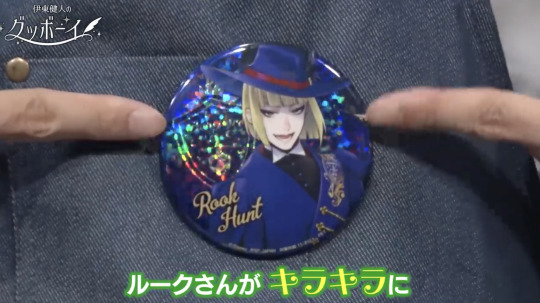
As seen above, two of the videos available are listed as #18 and #19, and yet there are only 12 videos available in the "Ito Kento's 'Good Boy!'" playlist. Rook's VA Itokawa's appearances in episodes #7 (Twst Gourmet: Beef Stew) and #8 (Twst Gourmet: Tofu Hamburger) are no longer viewable!
This is because the official Disney Games YouTube Channel will regularly delete its videos. I am not sure why, but maybe something related to VA appearances? (Most of the VAs come from different agencies, we have no way of knowing the content of one person's contract vs. the content of another's, and I have heard it is all very complicated!)
There used to be a lot more available, such as appearances by Rook's Itokawa, Floyd's Okamoto, Azul's Tamaru, etc. (clips of which can be seen in this compilation video), but videos like Azul's Tamaru hosting an entire episode about keychains, another about Octavinelle rhythmics and a third about Azul's English localization are now gone :<
74 notes
·
View notes
Text
How To Read and Understand Japanese Sentences (Part 2)
To catch who is doing what; who is the main subject and who is being affected by the action; you have to pay attention to the particles.
When a person is followed by the particle は such as (田中さんは…), the speaker is trying to tell you about Mr. Tanaka.
In other situations where the speaker wants to emphasize that IT IS Mr. Tanaka who did something, the particle が would be used instead (田中さんが…)
When an object is followed by the particle を, you know the subject is doing something to this object. If I say ご飯を…, you know the subject is going to do something to the meal. Whether he is eating a meal or cooking a meal, that... you have to read the verb at the end of the sentence.
In Japanese sentences, you will never know what happened to the object or what the subject did to the object until you read the verb at the end. For instance, if I say ドレスを…, the subject could wear a dress, buy a dress, draw a picture of a dress, sew a dress, or even steal a dress, etc. There are many possibilities to what the subject could do to a dress in that sentence. As a reader, you would never know until you see the verb at the end.
And to make a simple sentence longer, Japanese people would add extra details to describe about the subject or/and the object. Let's take a look at this simple sentence below.
女の子はドレスを着ています。
The little girl wears a dress.
This is the most basic sentence structure of Subject+Object+Verb.
You have no idea where this girl comes from, what kind of dress she is wearing, what colour is the dress, etc. Now, let's make it longer.
隣に住んでいる女の子は、先週の誕生日に私からもらったかわいいピンクのドレスを着ています。
The little girl who lives next door wears a cute pink dress which she received from me as a present on her birthday last week.
Now, you have a better image in your head about the little girl and the dress she is wearing. It enhances your imagination about the character and the storyline.
Let's take another sentence.
姉はチーズケーキを食べました。
My elder sister ate a cheesecake.
Again, there is very little to feel and imagine from this short sentence. Let's make it longer by adding some details about the cake.
姉は父が仕事の後、家に帰る途中で私のために買ってきたチーズケーキをうっかり食べてしまいました。
My elder sister accidentally ate the cheesecake that my father bought for me on his way home after work.
Now, you could feel the sadness and disappointment of the speaker towards the elder sister of what she did. And you also know where that cheesecake came from.
#japanese#jlpt#jlpt n1#jlpt n2#jlpt n3#jlpt n4#jlpt n5#language#learn japanese#nihongo#study notes#study japanese#study blog#studyblr#studyspo#kanji#hiragana#katakana
78 notes
·
View notes
Text
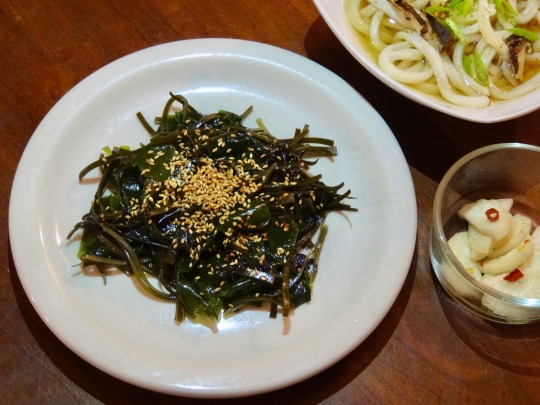

[ID: First photo shows a mixed seaweed salad topped with toasted sesame seeds; in the background are bowls of pickled daikon and kake udon. Second photo is a close-up showing light shining through the seaweed. End ID]
わかめと昆布サラダ / Wakame to konbu sarada (Seaweed and kelp salad)
A wide variety of seaweed-based salads are made by Japanese home cooks. They may contain only a mix of seaweeds and a dressing, but may also feature vegetables including cucumber, carrots, lotus root (レンコン / はす), daikon (だいこん), corn, edamame (枝豆), or onion. Dressings are as varied as cooks, and may be based around sesame oil (ごま油), rice vinegar (米酢), miso paste (みそ / 味噌), ponzu sauce (ポン酢), or mayonnaise (マヨ).
This recipe is a good way to use up reconstituted kombu and wakame that were steeped to make soup stock. It includes instructions for two dressings: one based on rice vinegar and sesame oil, and another with a sesame-mayo base.
"わかめ" or "ワカメ" ("wakame") is likely from "若" ("waka," "young") + "海布" ("me," "seaweed"); it is a particular species of edible seaweed (Undaria pinnatifida) that is farmed in Japan, Korea, and China. It is sometimes called "sea mustard" in English. Without further specification, "wakame" in a culinary context is taken to mean the leaves of the seaweed; these are the same leaves that are eaten in miso soup (みそ汁).
The etymology of "昆布" ("kombu" or "konbu") is unknown. It may be a phonetic Japanese reading of the Middle Chinese "昆布" (Mandarin: "kūnbù") (itself from "綸布" "*krūn pās," "green ribbon" + "cloth"), used to refer to various types of kelp and seaweed. In Japanese, the term refers to any of a few species of edible kelp from the Laminariaceae family.
Dried kombu is steeped to make one type of dashi ("出汁" / "だし"), a stock that is used in various soups and sauces. Once reconstituted, it may be steeped again to make 二番だし ("niban dashi," "second dashi"), sliced and simmered as one ingredient in a 煮物 ("nimono," simmered dish), or roasted and combined with other seaweeds and spices to make 振り掛け ("furikake").
"サラダ" ("sarada") is probably derived from the English "salad."
Note that the "seaweed salad" served at Japanese restaurants in the U.S. is not commonly eaten in Japan. It is shipped out to restaurants and stores pre-packaged, and is made with colored オゴノリ ("ogonori"; "agar" on ingredients lists), きくらげ ("kikurage"; "wood ear mushroom" or "fungus" on ingredients lists), and byproducts of wakame including 茎わかめ ("kukiwakame," wakame stem) and メカブ ("mekabu," wakame sprouts; both listed as "wakame" or "seaweed" on ingredients lists). You may be able to find this salad in the freezer section of your local Asian grocery store. If you want to approximate the texture of this salad at home, try buying some mixture of ogonori, kikurage, kukiwakame, mekabu, モズク ("mokuzu"), and/or ひじき ("hijiki"). Instructions for the dressing are below.
Recipe under the cut!
Patreon | Paypal | Venmo
Ingredients:
For the salad:
2 cups total reconstituted kombu, wakame, hijiki, or other kelp or seaweed
Vegetable additions to seaweed salads are possible and common. Try adding some cucumber, julienned carrots, sliced lotus root, sliked daikon radish, corn, edamame, or sliced onion that's been soaked in plum vinegar for 15 minutes.
If you're including cucumbers, slice them, salt them, allow them to drain in a colander for about 10 minutes, then gently squeeze them of excess liquid, to avoid making your salad watery.
For dressing 1:
1 Tbsp unseasoned rice vinegar (米酢)
1 Tbsp toasted sesame oil (煎りごま油)
1/2 kosher salt
1/2 tsp vegetarian granulated sugar
1/2 tsp Japanese soy sauce (しょうゆ / 醤油) (such as Kikkoman's)
2 tsp toasted sesame seeds (いりごま)
To make U.S. restuarant-style seaweed salad, omit the soy sauce; replace the sugar with high fructose corn syrup; and add a pinch of cayenne pepper, 1/4 tsp of onion powder or yeast extract, and a pinch of MSG.
For dressing 2:
2 Tbsp vegan mayonnaise
1/2 tsp unseasoned rice vinegar (米酢)
1/4 tsp dried ground shiitake mushroom, or vegetarian dashi powder
1/4 tsp vegetarian granulated sugar
Drop of djion mustard
Pinch kosher salt
1 tsp Japanese soy sauce (しょうゆ / 醤油) (such as Kikkoman's)
Drizzle of mirin (みりん)
2 tsp toasted sesame seeds, ground in a mortar and pestle or spice mill
If you eat eggs, you can replace the first five ingredients with 2 Tbsp Kewpie mayo (キューピーマヨ).
For a halal version, replace the mirin with an extra pinch of sugar.
Instructions:
For the salad:
1. Slice kombu into very thin strips. Slice wakame into thin strips, or leave as-is, as desired. Slice other flat dried seaweed into thin strips or bite-sized pieces.
For dressing 1:
1. Whisk all ingredients except sesame seeds together in a small bowl. Toss with seaweed. Top with sesame seeds and serve cold.
For dressing 2:
1. Whisk all ingredients together in a small bowl. Toss with seaweed. Serve cold.

83 notes
·
View notes
Photo

✿ 鶏むね肉のしそみそ焼き
#cook:鶏むね肉#cook:鶏肉#cook:しそ#cook:おおば#cook:なす#cook:砂糖×醤油×味噌#cook:味噌#cook:砂糖×味噌#cook:2020〜#cook#2020〜#cook:いりごま#レシピ:鶏むね肉#cook:肉
2 notes
·
View notes
Text
Fun fact: The name of every main character in grand maison Tokyo contains the name of a type of food or seasoning.
尾花夏樹 (おばな なつき)
ばなな:banana
早見倫子(はやみ りんこ)
みりん: mirin
平古祥平(ひらこ しょうへい)
こしょう: pepper
芹田公一(せりた こういち)
せり: celery
たこ: octopus
蛯名美優(えびな みゆう)
えび: prawn
松井萌繪(まつい もえ)
いも: potato
峰岸剛志(みねぎし つよし)
ねぎ: scallion
柿谷光(かきたに ひかる)
かき: persimmon/oyster
丹後学(たんご まなぶ)
ご ま: sesame
リンダ・真理子・リシャール (りんだ・まちこ・りしゃーる)
ちこり: chicory
久住琹奈(くずみ かんな)
みかん: orange
江藤不三男(えとう ふみお)
とうふ: tofu
相沢瓶人(あいざわ かめひと)
わかめ: seaweed
京野陸太郎(きょうの りくたろう)
のり: another type of seaweed, dried and edible, often used for wrapping sushi
Some of these are quite obvious like 芹田, 蛯名, and 柿谷 which already have food-related kanjis in them. And some of them are kinda reflective of these characters’ personalities. Banana in natsuki’s name is so cute, yellow one the outside and white on the inside. Mirin, the quintessential Japanese seasoning is symbolic of rinko’s cooking style, incorporating traditional Japanese ingredients into French cuisine. It’s no coincidence that both names of aizawa and kyono, who used to work with obana back in Paris, contain a type of seaweed. The versatility of wakame is representative of aizawa’s talent for paring ingredients. Nori, on the other hand, is very dry like kyono, difficult to eat it alone. Kyono is like nori in that he always needs partners.
#takuya kimura#木村拓哉#La grande maison Tokyo#グランメゾン東京#kyoka suzuki#鈴木京香#it just makes me wondering if the screenwriter came up with the food names first and then characters names or the other way around#editing this post was very exhausting as I had to switch between keyboards and I had around a dozen of keyboards on my phone😵
30 notes
·
View notes
Text
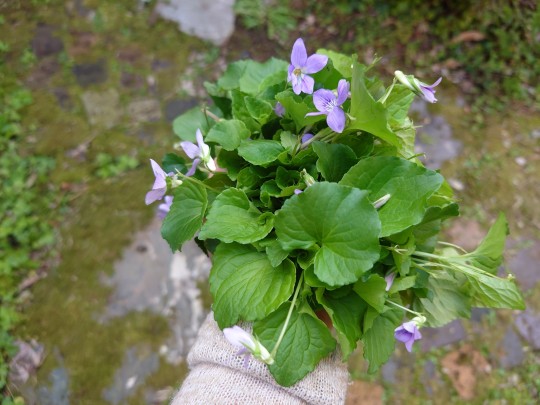
我が家には、けっこうな量のスミレが生えています。その昔、種が飛ぶ頃転げ回っていた、白っぽい猫のせいです。
木の下なんかの、そんなに固くなさそうなところを摘んで…
There are quite numbers of violets in my garden because a whity cat was running and rolling around before when they had seeds ...
Today I picked up some softer ones from sunshade...
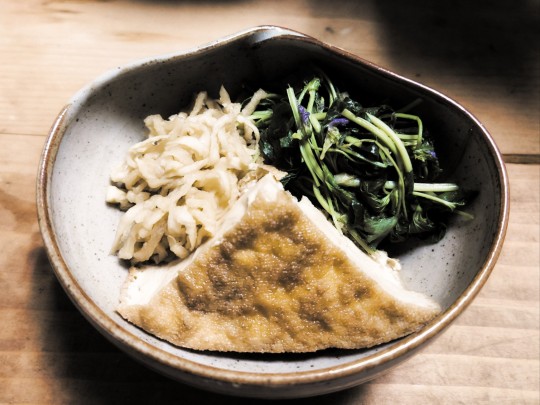
夕ご飯!厚揚げと切り干しとスミレの煮浸し!
and cooked my dinner!
258 notes
·
View notes
Text




Otomedia June 2016
(Below is a cleaned up machine translation. Please note that due to the nature of machine translation, the text may not be wholly accurate or may read oddly. Japanese is included after English for reference. The text was lifted from the images using this site, and though there's been care taken to make sure everything is correct, there is a chance of unintentional typos.)
With the Only one prince + superb honeymoon in paradise♡
Only oneの王子様と+楽園で極上ハネムー��♡
▼ Spade offers a handkerchief to Joker, who is soaking wet from the rain. Phoenix is in a panic because of the rain, which he doesn't like!
▼雨でびしょ濡れになったジョーカーに、ハンカチを差し出すスペード。フェニックスは、苦手な雨に大慌て!
Joker dressed up as a woman to participate in the World Bride Grand Prix. The exotic dress suits him ♪
世界花嫁グランプリ出場のため、ジョーカーが女装した姿。 エキゾチックなドレスがお似合い ♪
--Producer Mabuchi Yoshiki Interview
Joker and new characters such as Phoenix (Akai Tsubasa) and members of the "Devil Fang" organization led by President D continue their unpredictable adventures in "Kaitou Joker" Season 3. I'm sure your hearts are racing with excitement, but how about another thing that makes your heart flutter♥
This time, we have a fantasy of newlywed life with Joker and friends ♪ We also have special cooking tips for the future brides. Of course, the excitement will be even more intense in the full-length anime! We received the following secret information from producer Yoshiki Mabuchi of Shin-Ei Animation! The main highlights are Phoenix and Hosshi. Their mysteries will be gradually revealed during the 16 episodes between Season 3 and the upcoming Season 4. In Season 1 and Season 2, the story was rather complete, but in Season 3 and Season 4, the mystery will be solved by watching all the episodes. Also, the tricks this time were supervised by a real magician, RYOTA, who came up with the ideas for the tricks.
Let's explore the charms of Season 3 from various angles, such as the concepts of new characters and the event report manga, with Producer Mabuchi still with us. ♪
赤井翼ことフェニックスやプレジデントD率いる組織「悪の牙 《デビル・フ ァング》」のメンバーなど、ジョーカーと新キャラクターたちの予測不可能な大冒険が続く『怪盗ジョーカー』シーズン3。ドキワクの連続にみなさまの心は高鳴りまくっていることと思いますが、ここで一つ、胸キュンなトキメキもいかがでしょうか♥
ということで、今回はジョーカーたちとの新婚生活をたっぷり妄想♪未来の花嫁のために、ジョーカーたちから料理にまつわる特別コメントも入手しました。もちろん、アニメ本編でもドキドキはさらに加速!シンエイ動 画の馬渕吉喜プロデューサーからは、こんなマル秘情報をGETいたしました!!! 「要注目はフェニックスとホッシーです。 シーズン3の全16話と次のシーズン4 にかけて、彼らの謎が徐々に明かされます。シーズン1・2ではわりと1話完結に近い形で物語が進んでいきましたが、 シーズン3・4では全編を通して観ることで謎が解かれる仕掛けになっています。 また、今回はトリックもリアルマジシャンのRYOTAさんに監修していただき、 アイディアを出していただいています」
馬渕Pにまだまだお付き合いいただき、 新キャラクターの設定やイベントレポートマンガなど、さまざまな角度からシーズン3の魅力を探っていきましょう♪
--Character Question
Do you prefer to cook or to eat food cooked for you? 料理は作るのが 好きですか食べるのが好きですか?
Joker: "Of course I prefer to eat, Hachi makes the best curry~! My specialty is cup ramen! I'll treat you to some another time, okay?"
ジョーカー : 「もちろん食べる方が好きだな!ハチが作るカレーは最高なんだぜ~!得意料理はカップラーメンだな! 今度ごちそうしてやるぜ?」
Tsubasa: "Hm, I've never cooked before… Well, here's the question: if I were to cook, what would it be? 1. Super spicy curry, 2. Super spicy mapo tofu, 3. Konpeito Southern Cross style (very spicy). By the way, I like very spicy food."
翼「料理は作ったことがないな〜。 さて、問題。 僕 が作るとしたら何料理でしょう? 1激辛カレー、 2 激辛マーボー豆腐、 3金平糖サザンクロス風 (激辛)。 ちなみに僕は激辛料理が好物だよ」
Spade: "I guess it's hard to decide between cooking and eating. Dark Eye makes delicious food, so I leave it up to him, but when I'm stuck in a writing dilemma, sometimes I just make French food."
スペード: 「作るか食べる かの優劣はつけがたいか な。ダークアイが美味しいご飯を作ってくれるから任 せきりだけど、執筆に煮詰 まった時はひたすらフランス料理を作ることがあるよ」
--Mabuchi P (Producer Mabuchi Yoshiki) prediction
Mabuchi P big prediction★ What if you let the phantom thieves do your housework!?
馬渕P大予想★ 怪盗たちに家事を任せるなら!?
Joker "Likely has the ability to select good things, so it could be shopping."
ジョーカー 「良い物を選別する力 があると思うので、 ショッピングでしょうか」
Hachi "All the housework. He's the ideal wife that everyone wants (laughs)"
ハチ 「家事すべて。 もはや 誰もが欲しがる、 理想の嫁ですね (笑)」
Phoenix "He's sleeping all the time, so I feel like he's going to be a lazy house-husband (laughs)"
フェニックス 「ずっと寝ているので、 ダラダラした主夫になりそうです (笑)」
Shadow "He seems to take good care of people, so I guess it would be picking up the kids and taking out the trash."
シャドウ 「面倒見は良さそうなので、子どものお迎えやゴミ出しでしょうか」
Spade "He's also a novelist, so perhaps he might not do well with housework."
スペード 「小説家もやっている ので、家事向きではないかもしれないですね」
--Mini Talk
Reverse Proposal Tips! Phantom Thief Mini Talk ♪ What gift makes you happiest?
逆プロポーズのヒント!? 怪盗ミニトーク♪ プレゼントされて一番嬉しいものは?
Joker & Tsubasa: "A game!!" Spade: "You guys are so in-tune…" Joker: "No way! Okay, if you like games, let's play an action game!" Tsubasa: "That sounds fun!" Spade: "I'll pass. You really do like that sort of thing, you're like children." Tsubasa: "You just don't like losing, do you?" Joker: "Yeah, right!" Spade: "That isn't the case! Fine then, let's do it!" Wings: "By the way, what's an action game?" Joker & Spade: "Eh……"
ジョーカー&翼 : 「ゲーム!!」 スペード: 「キミたち気が合うね……」 ジョーカー : 「あわねーよ! よぉし、ゲームが好きだって言うなら、アクションゲームで勝負し 「ようぜ!」 翼: 「おもしろそうじゃないか」 スペード: 「僕はパス。 本当に好きだね、 子どもみたいだよ」 翼: 「そんなこと言って、負けるのがイヤなだけなんじゃないのかい?」 ジョーカー : 「そーだそーだ!」 スペード: 「そんなことあるわけないだろ! やってやろうじゃないか!」 翼: 「で、 アクションゲームってなんだい?」 ジョーカー & スペード: 「え・・・・・」
--Pg 58-59
Mabuchi P's Big Prediction ★ What kind of brides will the female phantom thieves be!? "Queen is rough around the edges and wants to do the housework but often fails. She will need someone like Roko to follow her through. Ai is versatile, and she also cooks when in her Dark Eye form, so I think she will make the best bride. Rose seems surprisingly caring; However, she has been asleep for a long time, so I think she will be studying and learning modern common sense."
馬渕P大予想★ 女怪盗たちはどんな花嫁になりそう!? 「クイーンは大雑把なので、家事をやり たがるけど失敗することが多そうです。 ロコのような目線で、フォローしてくれる人が必要ですね。 アイは多才で、 ダークアイの姿のときには料理もしていたので、一番良いお嫁さんになるのではないでしょうか。ローズは、 意外と世話焼き な気がします。 ただ、 眠っていた期間が 長かったので、 これから勉強して現代の 常識などを覚えていくのかなと思います」
--INTERVIEW Producer Yoshiki Mabuchi
What is the main theme of Season 3?
The characters are fundamentally the same as in Seasons 1 and 2, but we asked Miho Shimogasa to design them with a slightly more adult or "cool" look in mind. Phoenix, Hosshi, and "Devil Fang" became the main characters at the suggestion of director Yukiyo Teramoto and series director Dai Sato. Originally, the original author, Hideyasu Takahashi, had an idea for the Phoenix and the Divine Beast, and we pulled the concepts from a rough draft of that idea. There are still many mysteries about President D, but by creating an organization called "Devil Fang" and having rival thieves belong to it, it became easier to bring out various characters in the anime. There are many fascinating characters in the original story, and we want to include them in the anime as much as possible.
In Season 3, you seem to have included a number of concepts that are original to the anime.
Yes, that's right. The concept of Hosshi eating treasures and laying eggs, where key items of the story come out of, is also an original concept of the anime. On the other hand, Akai's three-choice questions are a concept that existed in the original story, and we decided to make use of it in the anime as well, so Akai always says the three-choice question every time he appears in the story. Mr. Sato raised the bar himself, saying, "I want the questions to rhyme nicely" (laughs). He had a hard time thinking about it.
Speaking of originality, Kaneko transformed into a murderous woman in episode 30. I was surprised because this was an idea that Director Teramoto had mentioned in the August 2015 issue of Otomedia.
It was an idea that Director Teramoto had been working on for a long time. The transformation scene was quite forced, but since it was a gag episode, I thought it would be okay (laughs). The next episode, episode 31, "Shadow and Eyes and Fakes" was also a gag episode, and everyone on the staff wanted to do it. Shadow also made an appearance for the first time in a while, and he too became more of a gag (laugh). We also introduced Fake Silver Heart and fake Roko, who were not in the original work. Fake-Silver is a robot and Fake-Roko is a skunk. In the original, Fake-Queen is the character who farts, but in the anime, we switched that concept to Fake-Roko. The cast is also spectacular, with Kenichi Suzumura as fake Joker, Toshiyuki Toyonaga as fake Spade, and Kaori Nazuka as fake Queen. The casting was done after asking Ayumu Murase, who plays Joker, who he would like to play a fake version of his character.
The opening and ending sequences were just as impressive as the previous and the OP was storyboarded by Takashi Otsuka, who also directed the previous season's OP, to match Arukara's "Miracle Shounen Boy 2" with an emphasis on coolness. Tasuke Inamura, the vocalist of Arukara, came up with the idea for the intro of the song, which includes the call "Hachi!" The ED is innovative, with Joker in red and the Hachi in blue, each running on a road in their image color. The ED is sung by Fuki Commune and fits perfectly with the song "Welcome to the Shining Night!"
What are the upcoming episodes and characters?
There are stories featuring DJ Peacock and Ali Baba. Stay tuned for a rendition of "Ali Baba and the Four Detectives." The story of Rainbow Justice will also involve the Devil Fang. In addition, watch for the original anime episode "The Sky Joker in Peril"! The story and tricks are completely original, and it takes place on Joker's airship, the Sky Joker. You will also see Joker's treasure room and learn about the inside of the ship.
INTERVIEW 馬渕吉喜プロデューサー
シーズン3のメインテーマは?
根本的にシーズン1・2と変わらない のですが、少し大人向けというか、カッ コよさを意識して、しもがさ美穂さんにキャラデザインをしていただきました。 フェニックスやホッシー、「悪の牙 《デ ビル・ファング》」が主軸になったのは、 寺本幸代監督とシリーズ構成・佐藤大さんの提案です。 もともと、原作者のたかはしひでやす先生のほうでフェニックスと神獣に関するアイディアがありまして、 そのラフ案から設定を引っ張らせていただきました。 プレジデントDに関してはまだ謎が多いのですが、悪の牙 《デビ ル・ファング》という組織を作ってライバル怪盗たちを所属させることで、いろいろなキャラクターをアニメに出しやすくなりました。原作には魅力的なキャラクターがたくさんいるので、できるだけアニメでも登場させたいと思っています。
シーズン3では、アニメオリジナルの設定が多数盛り込まれていますね。
そうなんです。 ホッシーがお宝を食べるとタマゴを生んで、中から物語のキーとなるアイテムが出てくるというのも、 アニメオリジナルの設定です。 逆に赤井が三択問題を出すのは原作にあった設定で、アニメでもそれを活かしてみようと思い、赤井が登場する度に必ず三択問題を言うようになったんです。佐藤さんが、 「きれいに韻を踏んだ問題にしたい」とご自分でハードルを上げていて(笑)。 考えるのに苦労されているようです。
オリジナルといえば、第30話でカネ子が殺子に変身しました。オトメディア2015年8月号で、寺本監督が語っていたアイディアだったので驚きました。
寺本監督がずっと温���ていたアイディアだったんです。 変身シーンはかなり強引でしたが、ギャグ回なので大丈夫かなと(笑)。続く第31話 「影と瞳と偽物と」 もギャグ回で、スタッフみんながやりたがっていたエピソードでした。シャドウも久しぶりに登場して、彼もだいぶギャグ色が強くなってきましたね(笑)。原作にはいない、二セシルバーハートや二セロコも登場させました。 ニセシルバーはロボットで、ニセロコはスカンクですね。原作だとニセクイーンがオナラをするキャラクターなのですが、アニメでは その設定をニセロコに持っていきました。 キャストも豪華で、ニセジョーカーを鈴村健一さん、二セスペードを豊永利行さ ん、ニセクイーンを名塚佳織さんが担当しています。これはジョーカー役の村瀬歩さんたちに「ご自身の担当キャラの偽物をやってもらうなら誰がいいか」と希 望を聞いて、キャスティングした形です。
本編と同じく、オープニングとエンディングの映像もとても印象的でした。OPはアルカラの「怪盗ミラクル少年ボーイ2」にあわせ、前シーズンでもOPを担当していただいた大塚隆史さんに、 カッコよさを全面にだして絵コンテ演出をしていただきました。 アルカラのボーカルの稲村太佑さんのアイディアで、 イントロに「ハチ!」という掛け声が入っているんですが、そのタイミングでハチが画面に登場していますよ。EDは斬新でジョーカーなら赤、ハチは青と、各イメージカラーの道の上を走る構成です。 Fuki Communeさんが歌う「輝く夜へようこそ!」ともピッタリ合っていますよね。
―今後の注目エピソード&キャラは?
DJ・ピーコックがメインのお話や、 アリババが登場するエピソードがあります。 「アリババの4人の探偵団」の描写は、ぜひご期待ください。 レインボー・ジャスティスのお話には、悪の牙 《デビ ル・ファング》も絡んできますよ。 そして、アニメオリジナルエピソード「スカ イジョーカー危機一髪」にも注目です! ストーリーもトリックも完全オリジナルで、ジョーカーの飛行船「スカイ・ジョーカー」が舞台になってます。 ジョーカーのお宝部屋なども出てきて、スカイ・ジョーカーの内部が分かりますよ。
65 notes
·
View notes
Quote
日本語では一つの名前で表されるのに英語だと二種類以上あるもの
[B! 増田] 日本語では一つの名前で表されるのに英語だと二種類以上あるもの
たとえばつぎのようなもの、というお題。
亀 - Turtle (海亀)、tortoise (陸亀) ワニ - Alligator, Crocodile
- - - - - - - - - - - - - - - -
はてなブックマークがトリビアの披露大会になっていて、知識が集まってる。 逆パターンも 「英語では一つの名前で表されるのに日本語だと二種���以上あるもの」
- - - - - - - - - - - - - - - -
日本語では一つの名前で表されるのに英語だと二種類以上あるもの
聞く:hear, listen 見る:see, look, watch 海:sea, ocean, waters, marine(海の) 仮説:hypothesis, assumption 罪:crime, sin (「罪と罰」の罪は以外なことにcrimeのほう *)
英語では一つの名前で表されるのに日本語だと二種類以上あるもの
Museum:美術館、博物館 Requirement:要件、要求 Space:空間、宇宙
- - - - - - - - - - - - - - - -
「総称だけ存在して、細かな違いを呼び分けない」ものと、「総称は無いが、個々の細かな呼び分けだけある」ものに分けられるかも。 総称:亀 / 個々に:Turtle (海亀)、tortoise (陸亀) 総称:皿 / 個々に:dish、plate、saucer 総称:brother / 個々に:兄、弟
- - - - - - - - - - - - - - - -
秋のAutumnとFallのパターンは、意味もニュアンスも同じで、言い方が違うだけかな。 Fallが「秋」「落下」の2つの意味。
- - - - - - - - - - - - - - - -
仕事(taskとworkとjob)
槍:スピア、ランス、ジャベリン、トライデント。/悪魔:デビル、デーモン
managementもadministrationも(場合によってはcontrolも)「管理」、featureもfunctionalityも「機能」
一番有名なのはネズミ(mouse, rat)だと思ってた。他にもphantom/ghost、coast/beach、house/home、college/university、space/universe、earth/globeとか。厳密には意味が違うんだろうけど。
カラスのravenとcrow。
好き(loveとlike)/時計(clockとwatch)/サイン(sign、signatureとautograph)
言語とその話者の世界観が相関することは言語的相対論と呼ばれる。国がcountry, nation, stateに分かれるのは島国と多民族大陸国との違い。https://gijodai.jp/library/file/kiyo2011/yoshitaka_sato.pdf
ApeとMonkey
AlligatorとCrocodileの違いは、口を閉じたときに下の歯が見えるかだって伊豆で習った。
ちょっと違うが、"将来に対する希望"と、"睡眠中の幻覚体験"を日本語でも英語でも「夢 dream」という一語で表現するのは全くもってピンと来ない。
麦は日本語でも大麦・小麦・ライ麦・エン麦は区別はしてるけど、英語ではbarley wheat rye oatで「麦」に対応する単語がないのよね
アプリ開発で Apple の審査担当とやり取りする際「修正」の言い方が複数あって fix, correct, modify, revise, alter などを使い分けてくるので毎回意図を汲みとれてるか不安になる。(まあ日本語にも修正の類語いっぱいあるけど)
「毒」 poison / venom / toxin
romanceとnovel。romanceは通常騎士道物語など物語と訳されるのだけど、小説と訳されているときもある。
CollegeとUniversity
試験: 学力・知識を問う→examination,quiz,test 評価や実験→experiment 試みる→trial▼ただ「試験」で纏められるだけで日本語でも「考査」「実験」「試行」と分けて書くこともできるが。
自由(Liberty,Freedom)。契約などの法律上のやり取りが単語を増やした気もする。
紫→purple,violet
夫、旦那、亭主、主人→husband
足の指(toe)もfinger じゃない
日本語において、髭は全て「髭」で、生えてる箇所を限定する場合は「顎髭」や「頬髭」などと熟語で表現するが、英語ではそれぞれの箇所に単語がある。
リス:squirrel、chipmunk
馬車がとてもややこしくて面倒くさい / 辻馬車 cab, hansom 荷馬車 (horse)cart, wagon, (horse-drawn)carriage, horse and buggy 駅馬車 stagecoach 二輪馬車 curricle, tilbury ,jaunting car ,jinker 馬二輪戦車 chariot まだまだいっぱい…
今話題のsexとgender
政治家 politician / statesman たまご egg / spawn / roe ちなみに逆もあってegg 卵 / 玉子
この手の単語なら調理法が多い。アメリカは焼く文化だ。肉、パン、物で違う(Grill、Bread、Burn、BBQなんてのも)一方で日本は煮る文化だ。煮る、茹でる、炊く、煮込む。英語はBoil、あるいは残り全てはCookだ。
おじさんとおばさん、日本語でもこだわりがある場合には年上か年下で漢字が違うらしい。中国語では母方と父方で別の名前になる。
- - - - - - - - - - - - - - - -
知里真志保によれば、大和民族が川の始まりと考える「みなもと(源)」をアイヌ語では「川の終り」と言うのだという。つまりアイヌは川を海の方から見ているのだと。
コメントで日本語は部位に依らず「髭」だけってあるけど、いちおう漢字だと「髭(くちひげ)」と「鬚(あごひげ)」と「髯(ほおひげ)」で使い分けられる。発音はぜんぶ「ヒゲ」だけど……
- - - - - - - - - - - - - - - -
言語学で言うところの有標と無標も関係してそう。 作家:男女問わず作家の全般、女流作家:作家の中で女性の場合
標識 (言語学) - Wikipedia
英語のlionは雄雌どちらのライオンも表すが、lionessは雌だけである。前者が無標で後者が有標である。
133 notes
·
View notes